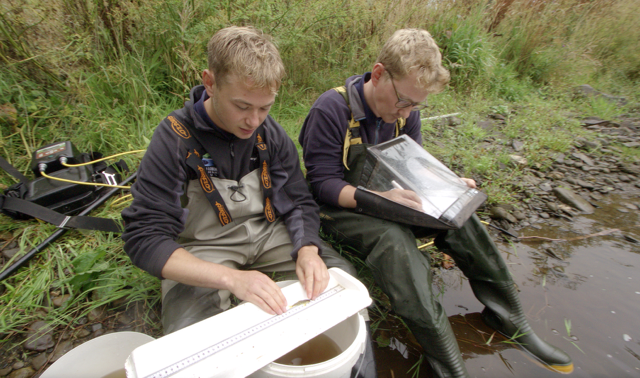James Hawkins and Jamie Carruth make up the monitoring team for the Wye and Usk Foundation and explained why last year’s results were so welcome.
“We’ve got 150 sites in total, 70 of them are on the Usk and 80 of them are on the Wye,” they said.
“If you can catch 30 juvenile fish at a site it is indicative of a good population, if you find anything less than 10 the population is in some danger.”
Electro fishing is where a team pass a small current through the water which temporarily stuns the young fish for long enough so they can be caught. The fish are then measured and released.
2023 results were generally poor, with the best result across all 150 sites on the two rivers being 29. Most sites returned zero to five.
There had been a steady decline of salmon and trout in the rivers for roughly four decades and there were serious concerns that the species would go extinct from the Wye and Usk if the trend continued.
However, results in 2024 left the foundation more buoyant after a surprising catch of 166 juvenile salmon at one site.
“The scale of that is massive,” Jamie said.
“Not only did we find salmon at a massive amount at more sites than we did last year, but probably more than we have found on any survey in the last decade.”
“The return was five times as much as we found at the best site last year.”
The results are the best in recent history, with ideal conditions for both young and adult fish cited as the main reason for their return in such volume.
Sustained, but not intense, rainfall is one reason the pair think salmon survived so well last year, with a healthier level of water in the river making conditions ideal for the survival of eggs and the return of younger salmon from sea back to the rivers.
The difference a strong spring flow makes is crucial, with survival rates as low as 10 per cent when they’re at their weakest.
The dry start to 2025, including the hottest start to May on record, is less suited to salmon and trout for this reason and the foundation hopes populations won’t have taken a large hit.
“Good flows in the river help young salmon get back out to sea, where they spend two years and return as adults,” Jamie says.
“But the good spring flow also allows those adults to return and breed, hence why we saw so many young salmon in the river last year.”
“Conditions this year are less ideal, but any return which is well between the 2024 and 2023 figures will indicate there is still a strong presence in both rivers.”





Comments
This article has no comments yet. Be the first to leave a comment.